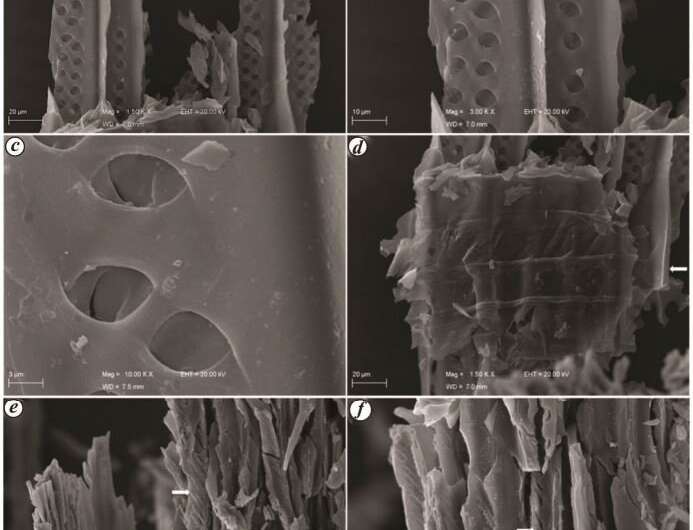India had massive wildfires between 145 million and 100 million years ago

What can fire reveal about Earth's past? This is a question that a group of researchers linked to the Postgraduate Program in Environment and Development (PPGAD, acronym in Portuguese) of the University of Vale do Taquari–Univates seeks to answer. They develop studies in the areas of paleobotany and paleofires. Evidence of fires, including the macro-charcoal, are important instruments to expand the understanding that we have about natural systems and environments from millions of years ago. Univates' research activities in the area take place in the Laboratory of Paleobotany and Biome Evolution of the Science Museum.
Last October, a group of Brazilian research institutions, including Univates, revealed an unprecedented study on the occurrence of paleofires in Antarctica 75 million years ago, in the Cretaceous period. This scenario has been expanded with further studies and, now, a new research developed in partnership between Univates and three other institutions attests that India also had fires in the Lower Cretaceous, in a period between 145 million and 100.5 million years ago.
The new study, published in the journal Current Science, takes a look at a part of India where macro-charcoal (fossil charcoal) records were non-existent. This location corresponds to the Saurashtra sedimentary basin, which in the present-day represents Saurashtra region of northwestern India and close to the Arabian Sea.
The study is signed by Gisele Sana Rebelato and it is part of her doctoral thesis developed at PPGAD. The thesis advisor, Professor Dr. André Jasper, also collaborated with the research as well as Ândrea Pozzebon Silva and Júlia Siqueira Carniere, who are students of the Biological Sciences course and work in scientific initiation scholarships, both from Univates. Other members who sign the work are Alpana Singh, Shivanna Mahesh, Bhagwan D. Singh, from Birbal Sahni Institute of Paleosciences, India; Márlon de Castro Vasconcelos, from the State University of Rio Grande do Sul; and Dieter Uhl from Senckenberg Research Institute, in Germany, and visiting professor at PPGAD.
The importance of paleofires studies
Plant fires are common events in modern and past ecosystems, being an important evolutionary driver of biodiversity and ecosystem dynamics since the emergence of the first vascular plants in the Silurian period, an interval ranging from 443.8 million to 419.2 million years. In general, after the fire, plants that did not undergo complete combustion can be incorporated into sediments and fossilized as macro-charcoal, thus providing evidence of paleofires occurring in paleoenvironments in deep time.
The study of these records is important and allows drawing conclusions about the composition of the vegetation affected by the fire and some of the conditions of the surrounding areas as well as expanding the knowledge about the geological past of a given location. Considering the occurrence of macro-charcoal, only a few records have been published for the strata in India and they are mainly originating from the Permian deposits (from 298.9 to 251.9 million years ago).
"Paleofires occurred concomitantly with the emergence of the first terrestrial plants and were distributed throughout Planet Earth, occurring at different intensities. As fire is one of the factors that have shaped biodiversity over millions of years, fossilized plants, including the macro-charcoal, provide information about the vegetation that was burned and about environmental and climatic conditions over deep time," describes researcher Gisele Sana Rebelato.
Although the Cretaceous is globally considered a range with the concentration of large volumes of paleofires, only a single macro-charcoal record and two micro-charcoal occurrences have been published so far for this range from India. "Although previous work has indicated the occurrence of paleofires in the Cretaceous of India, this study confirms that the distribution of paleofires in the Cretaceous was wider than usually imagined, reaching what is now known as northwest India," details Jasper, thesis advisor whose results were published in the article.
The author of the work reveals that the research on this topic was motivated by the lack of studies on paleofires occurred in India during the Cretaceous and by the total absence of macro-charcoal records for an entire sedimentary basin, in this case the Saurashtra basin. "This information gap raised the question of whether or not there was fire in the area, and, if so, which vegetation gave rise to the macro-charcoal. These questions, this restlessness that is inherent to scientific research, can help to try to understand what the environment was like under the influence of paleofires," she details.
Scientific research indicates that the Cretaceous was one of the periods with the highest incidence of paleofires in the history of the Earth, a high concentration of (paleo)oxygen, high temperatures and the delimitation of current continental limits through continental drift. However, the distribution of these fossilized coal records is uneven between hemispheres—the Northern Hemisphere has a much higher amount of records than the Southern Hemisphere. Given this context, researches such as Gisele's contributes to establish new limits for scientific knowledge in the area.
"Therefore, the study helps to understand the distribution in the Southern Hemisphere—remembering that in the Cretaceous India was in the Southern Hemisphere, since paleofires are expected to have similar occurrences in both hemispheres. In this Cretaceous global scenario, our study provides yet another important evidence that fires could indeed occur in greater volumes, even though there are still some places in the Southern Hemisphere with regional and temporal gaps, which acted in the dynamics involved in the evolution of ecosystems until today," adds Gisele.
In addition, by looking at the past, the study helps to understand the functioning of both deep time and present natural systems, and it can help understanding the natural and anthropic processes related to climate change currently underway on Earth.
More information: Gisele Sana Rebelato et al, Macro-charcoal in carbonaceous strata of the Lower Cretaceous of northwest India: remains from the Than Formation, Saurashtra Basin, Gujarat, Current Science (2022). www.currentscience.ac.in/Volumes/122/02/0205.pdf
Provided by University of Vale do Taquari





















